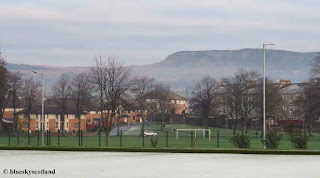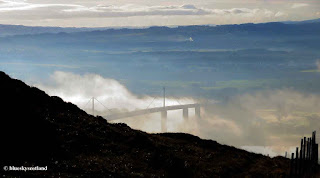ALL PHOTOS CLICK FULL SCREEN.
A few weeks ago I decided to do another walk in Dumbarton I'd found on the Glasgow AZ map/ book. A thin dotted line ran up the right hand bank of the River Leven and as it was a completely new walk for me, a rare event in itself, I fancied a go at it. River Leven at Dumbarton, above. It was another grey December misty morning so I began to doubt my choice of destination and wondered if I'd see anything at all as I was walking up a river system, not climbing a hill to rise above the mist level.
It turned out fine though and the mist hanging over the river only added to the atmosphere, like black and white period films of the notorious London Fog. The thickest mist/fog bank seemed to be out in the main River Clyde Estuary channel again so maybe by heading inland I'd have better luck.
Winter trees. As it was fairly thick to begin with I went a walk in the nearby park first just to see if good mist effects were occurring there and by the time I returned to the town the morning mist was starting to clear up inland.
A weak sun even appeared. The normal cycling/walking path is up the left hand bank of the river. The right hand bank is much quieter, slightly wilder in places, but also runs past a couple of industrial estates so it's a mixed bag of experiences.
The path starts off in Dumbarton once over the main road bridge near Dalreoch Train Station, good at first on tarmac/concrete slabs then narrows down to a grass strip beside the river. Easy to follow on foot it soon gets twisty and very narrow in places, winding between thorn bushes at times so not suitable for bikes further on as it would be tedious and time consuming instead of enjoyable. So narrow at one point I was hanging onto a fence to avoid the swollen river below.
No problem on foot though. This is passing the industrial estate.
Passing the area known as the Leven Swamp, looking back towards Dumbarton. The Leven Swamp is basically the flood mashes of the river on both sides as the Leven is the only outlet for the 23 mile long Loch Lomond and surrounding mountains/streams so has to empty a vast area quickly during wet weather and often bursts its banks here, spreading out further at this point in winter. Currents in spate conditions can be deep and powerful in the main channel so if you fell in you might end up in Greenock quicker than you would like. It's a very fast river at times and you would not stand much of a chance once in its grip.
Although the Leven is a fairly short river it is an impressive one and seals and other sea life have been known to frequent these brackish margins, even venturing upstream at full high tide to negotiate the various small rapids into the freshwater loch itself, as did the Vikings on raiding parties.This gave them boat access to a large fertile area inland. Robert the Bruce, King of Scots, retired here, his last few years spent in a mansion house on the banks near Renton, hunting ducks and fishing when he felt well enough to venture out.
The Leven Swamp, looking upstream.
The icy slopes of Ben Lomond seen across the river. Very few other walkers on this secluded path.
The path also skirts the town golf course at one point, thick with overnight frost at minus 4 degrees.
Another view of it here with the Lang Craigs looming behind.
Further on the narrow path climbs to a high trail above the river then runs through woods. You can either continue on into Alexandria and then return down the left hand bank via a town bridge or, as I did, return through the Strathleven Trading estate, which is more scenic and green than the name suggests on good pavements and other tarmac ribbons as it used to be a large formal estate in the old style of the name.
Strathleven House, once a grand mansion surrounded by its own private grounds but now an HQ with local offices within the trading estate.
Further down you pass Andy Scott's magnificent stag at Lomondgate as you enter Dumbarton again.
Another view of it from the sunlit side. The base it stands on is just as interesting as the stag itself. Similar to a water reflection, but cast in metal.
Dumbarton's Bellsmyre Housing estate with the cliffs of the Lang Craigs behind. The weathered remains of an ancient lava flow.
Dumbarton at one time was famous for its shipbuilding, its whisky distilleries, and its glass ware but like most post industrial towns it's not as wealthy as it once was.
But you can still see from its older buildings it did have money to spend at one time. Braehead primary school here, solidly constructed to last for centuries.
Period tenements on Dumbarton's modest but interesting heritage trail. Built in 1906 going by the elaborate date carving on a wall.
The town's municipal buildings and office HQ. A 1900 confection in old red sandstone, which is a local quarry stone found around the River Clyde Estuary offering feature buildings of great merit in many Scottish west coast towns and the City of Glasgow, famed for its old red sandstone Victorian and Edwardian street architecture, similar in style to this.
The elephant and castle. Denoting strength and impregnable defenses. Throughout many centuries Dumbarton Rock and its fortress/castle, from the iron age on-wards, protected this stretch of coast from hostile forces. A hard nut to crack although the Vikings eventually managed it with siege tactics. The City of Coventry also has an elephant and castle as its coat of arms, plus wildcats with banded tails, and London of course has the most well known example at Southwark.
The statue of Peter Denny, one of a family of shipbuilding brothers he went on to dominate the sides of the River Leven at its deepest, where it ran into the larger River Clyde, building a string of famous ships in his yards to export around the world throughout the mid to late 1800s.
Late afternoon sunlight back in Dumbarton.
And a glorious December sunset over Renfrewshire to end.
A good easy walk of a few hours duration, longer if travelling on into Alexandria then back down the other side. Grass paths mainly on right bank. Not too much mud at present. Right hand route unsuitable on a bike due to narrow paths, twisting up and down nature and slow progress in places through undergrowth.








































































